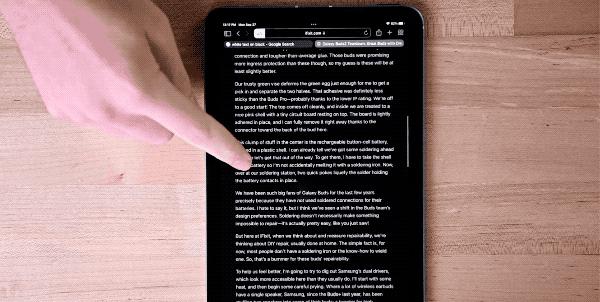Financial Associated Press | New Consumption Daily (reporter Tang Zhixiao) news, on the iPad mini 6 appeared in the large area of "jelly screen" problem, the United States Colorado users officially filed a class action lawsuit, accusing Apple of knowing that the product defect is still selling, suspected of false publicity and fraud.
In response to the "jelly scrolling" problem when the iPad mini 6 is vertical, Apple responded to the media that this is the normal behavior of lcd screens. Because these screens refresh line by line, this causes a delay issue between the top row and the bottom row of the screen, which can lead to a "jelly scroll" effect.
The well-known dismantling website iFixit said that this phenomenon is common on the display, but this phenomenon may be more prominent on the new iPad mini, because the control panel of the display is installed vertically inside the device, rather than horizontally like the fourth generation of iPad Air, in other words, the controller of the iPad mini 6 panel is designed near the long side.

Image credit: iFixit
The so-called "jelly screen" is when the device is in a vertical state, and there is a slight imbalance in the text display. Specifically, the text on the left scrolls more slowly than the text on the right when scrolling. If you are using the device in landscape mode, the perception will not be too obvious.
iFixit also tried to check the condition of the jelly display on the iPad Pro, which was also placed on the long side of the controller. The iPad Pro, which has a high screen refresh rate, can indeed better control the jelly display. However, if you look back and forth in slow motion, you can still find a similar display effect when sliding text vertically.
Overall, the "jelly screen" that appears on the iPad mini 6 is a problem in Apple's hardware design, and it is not much related to screen suppliers and assembly manufacturers, and finally this problem cannot be solved by the later OTA upgrade. Apple can only be expected to improve the design in subsequent models, or replace the OLED screen with a higher refresh rate to solve the problem.
In fact, this is not the first time apple has faced a class-action lawsuit over hardware design issues. Legal proceedings similar to the iPad mini 6 "jelly screen" still need several years to come out.
As early as 2018, Apple was sued by users in many countries to courts in different regions because software updates would slow down the speed of older iPhones.
The incident ended after 2 years and ended with Apple reaching a settlement with compensation to appellants in multiple regions.
It is worth mentioning that because Apple mobile phone users in the mainland did not use the law to sue Apple, Apple's compensation was only for American users, and Chinese users did not receive compensation.